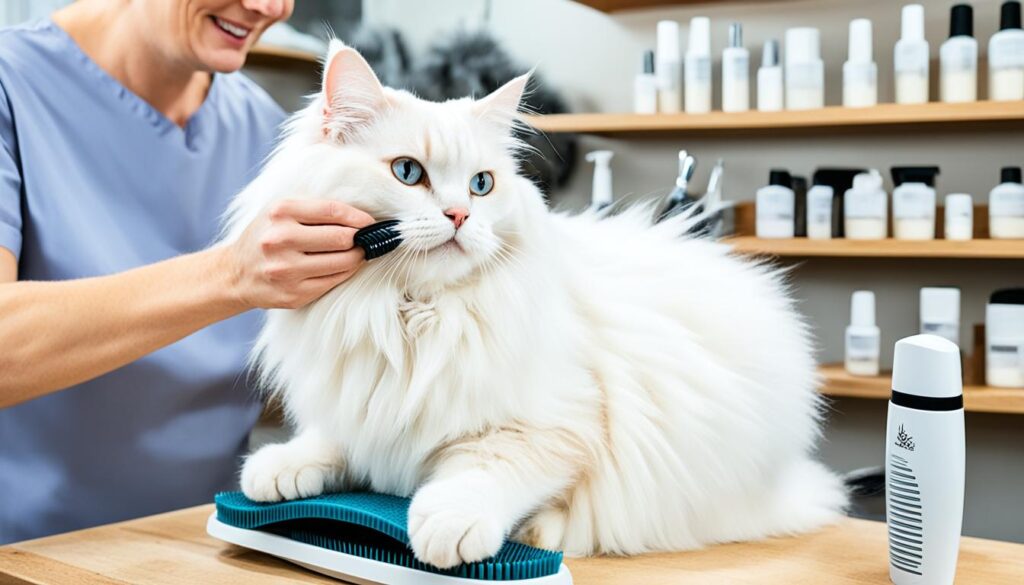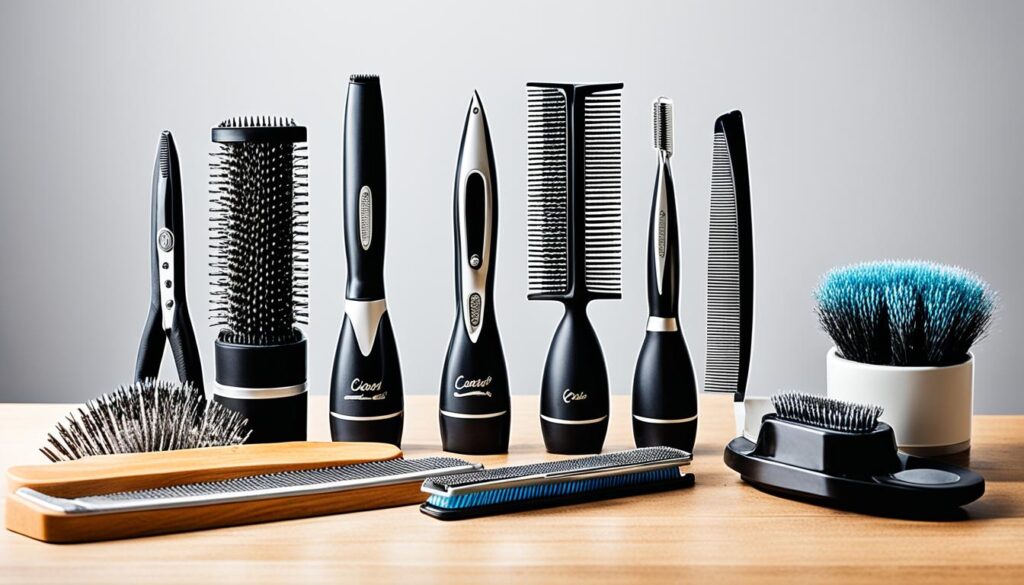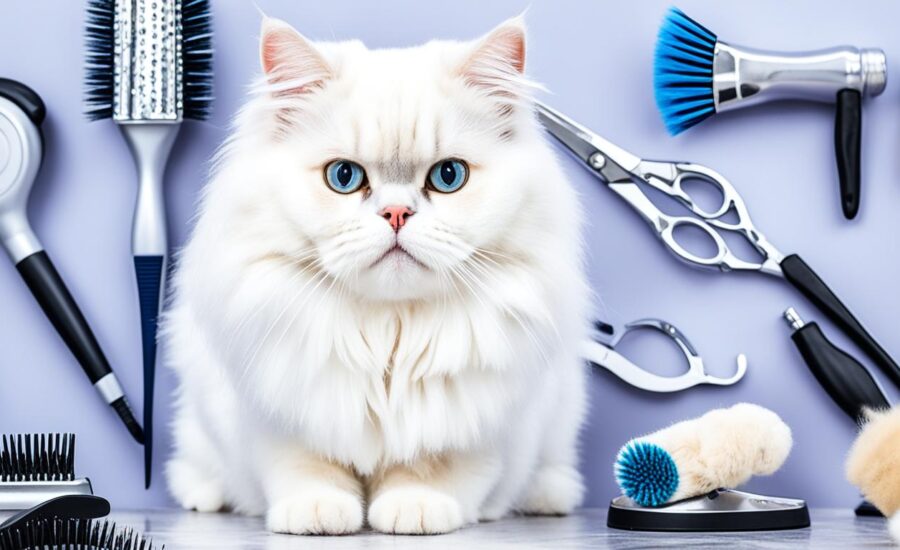Grooming your cat is often viewed as just for fun. But, is your cat’s independence hiding their need for a clean coat? Knowing the right grooming techniques and tools is key for their health and happiness.
Each cat breed, from majestic Maine Coons to sleek Siameses, needs a special grooming approach. This helps get rid of dirt and cut down on hairballs. Starting to groom your cat early helps them take better care of themselves when they get older. Keeping a regular pet grooming schedule can spot skin and fur issues early.
Every cat, young or old, short-haired or long-haired, needs grooming that meets their specific needs. Are you ready to offer cat care that goes above and beyond? With the right brush, let’s explore how to make our cats’ lives better, one stroke at a time.
Key Takeaways
- The importance of regular grooming for both short and long-haired cats.
- How proper grooming techniques contribute to a cat’s health beyond just a clean appearance.
- Why starting grooming at home early can benefit your cat in the long term.
- Grooming plays a key role in uncovering potential health issues unnoticed by the untrained eye.
- Understanding your cat’s breed and hair type is crucial for customizing your grooming routine.
- Grooming is not just about cleaning—it’s also about bonding with your feline friend.
The Advantages of Regular Cat Grooming
Regular grooming impacts a cat’s health and mood greatly. It puts cat hygiene and cat care at the forefront for pet owners. They experience the joy of caring for their feline pals. Let’s dive into the benefits that come from grooming regularly.
Health Benefits: Skin & Coat Maintenance
Brushing cats is essential for a healthy coat and skin. It removes loose fur, cutting down on hairballs. This lessens stomach problems from ingested hair. Brushing also boosts blood flow, which improves muscle tone and overall health benefits. It makes cats more agile and healthy.
Behavioral and Comfort: Reducing Hairballs and Improving Muscle Tone
Grooming boosts a cat’s comfort and behavior. It gets rid of mats, so cats avoid discomfort and move easily. This care makes kittens social and easy to adapt, easing their future interactions.
Long-Term Care: Parasite Management and Insulation Regulation
Regular grooming keeps your cat’s coat fine, aiding in parasite management. It spots fleas and ticks early, preventing health issues. A groomed coat keeps the cat’s natural warmth, essential for managing body temperature. This highlights the role of feline grooming in long-term care.
Cat Grooming: Brushing Up on Your Technique
Getting better at cat grooming helps keep your pet healthy and brings you closer together. Whether you’re a newbie or a pro in pet grooming, knowing about different cat breeds and their coats is key. For short-haired cats, use a metal comb and brush following the fur’s natural growth.
Long-haired cats need more care to avoid knots, especially around their belly and legs. Brush gently from their tail towards their head to avoid pulling and keep their fur smooth. When you brush them, it’s also good to check their skin for anything unusual like bumps or parasites.
Brushing does more than just remove loose fur and dirt. It’s also a calming activity that improves their skin health by boosting blood circulation. Make grooming a regular thing so your cat looks forward to it. This makes grooming easier and strengthens your bond.
| Coat Type | Brushing Tool | Technique |
|---|---|---|
| Short-haired | Metal Comb | Brush in the direction of hair growth |
| Long-haired | Wide-toothed Comb | Start from tail, move towards head |
| Areas Prone to Matting | Detangling Brush | Gentle strokes, focusing on matted sections |
Using good pet grooming methods isn’t just for looks. It also plays a big part in your cat’s health. So, regular brushing and taking care of grooming at home can vastly improve your cat’s life. These grooming tips are crucial for all cat owners.

Creating the Perfect At-Home Grooming Station
For pet lovers, setting up a home grooming space is key. We’ll show you how to create a grooming station with all the necessary tools. This makes grooming at home a fun bonding moment with your cat.
Essential Grooming Tools for Your Feline
A good home grooming station has several key tools. Choose soft brushes that are kind to your cat’s skin. You’ll also need grooming scissors, tweezers, and nail trimmers designed for safe pet use. For cats with long hair, a mat splitter is crucial for gently removing tangles.
- Brushes: Different types for different coat types
- Scissors: Safely trim and shape fur
- Nail Trimmers: Keep claws at a comfortable length
- Tweezers: For precise grooming tasks
- Mat Splitter: An invaluable tool for long-haired cats

Setting up for Stress-Free Grooming
It’s important to make grooming calming for your cat. Pick a quiet, tidy spot where your cat feels secure. Adding toys and blankets can make the area more welcoming. Plus, treats can turn grooming into a fun activity.
- Location: Select a quiet, low-traffic area in your home.
- Comfort: Use blankets or beds that your cat loves.
- Tools Accessibility: Keep all grooming tools easily reachable.
- Rewards: Have treats and toys to make grooming a pleasant experience.
By following these grooming tips and setting things up thoughtfully, grooming your cat at home is simple and enjoyable. Using the right tools and creating a calm space are vital for home pet grooming success.
Step-by-Step Guide: Brushing Different Cat Coats
Brushing your cat’s coat is key in any setting. Each coat type needs specific care to keep your cat happy and healthy. Whether it’s a short-haired or long-haired cat, this guide helps keep their fur looking its best.
Short-Haired Cat Brushing Techniques
Short-haired cats need regular grooming to stay looking neat. Use a metal comb or soft brush from head to tail to remove loose fur. Brushing in the direction of the hair helps spread natural oils, making their coat shiny and healthy.
Long-Haired Cat Grooming Strategies
Long-haired cats’ beautiful coats can easily tangle without care. Start with areas prone to mats using a long-toothed comb. Brush gently to avoid causing stress. This keeps their fur beautiful and is a great way for you two to bond.
Managing Matted Fur and Sensitive Areas
Be patient when dealing with mats. Work from the tips to the skin to avoid pain. Use light strokes near the face and paws. Grooming should be calming, building trust while you care for their coat.
FAQ
What are the necessary grooming tools I need for my cat?
How often should I groom my short-haired cat?
How can I reduce stress for my cat during grooming?
What are the benefits of regular grooming for my cat’s health?
Why is it important to start grooming my cat from an early age?
Should I bath my cat as part of the grooming routine?
How can I deal with my long-haired cat’s tangled fur?
What are some signs of underlying health issues I should look for while grooming?
How do I trim my cat’s claws safely?
Can regular grooming improve my cat’s behavioral issues?
Source Links
- https://basepaws.com/cat-insider/cat-grooming-essential-tips-and-techniques
- https://us.tangleteezer.com/blogs/inspiration/cat-grooming-101-how-to-groom-your-cat
- https://nationalcatgroomers.com/product/exams/

